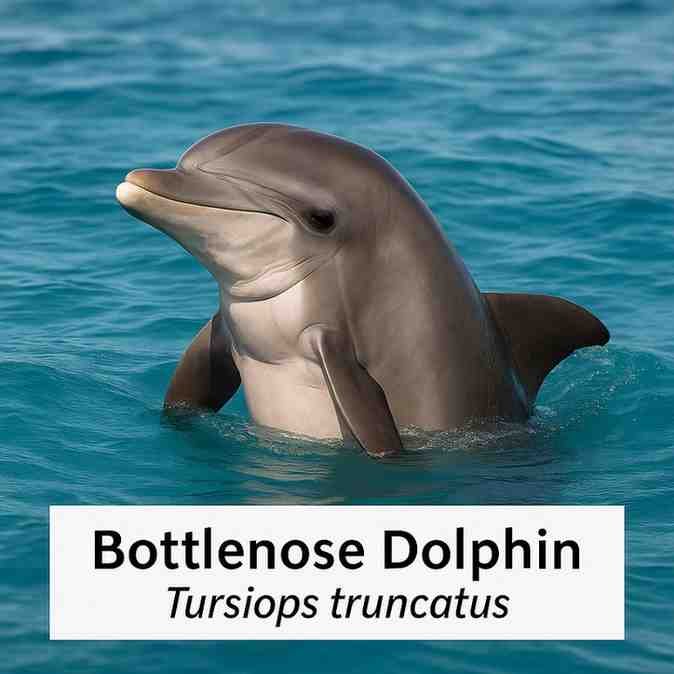What is the scientific name for a dolphin? The dolphin scientific name is Cetacea (Infraorder).
Dolphins are the most intelligent and affectionate marine animals in the world. They are well-known for their social behavior, acrobatics, and communication skills. Dolphins have long been of great use to research scientists and ocean lovers alike. This article discusses the dolphin’s scientific name, genus, meaning, pronunciation, classification, diet, habitat, communication, and essential facts about different dolphins.
Table of Contents
Dolphin Scientific Name, Meaning & Pronunciation
What is the Scientific Name of a Dolphin?
- Common Dolphin Scientific Name: Delphinus delphis
- Bottlenose Dolphin Scientific Name: Tursiops truncatus
Pronunciation of the scientific name of the dolphin
- Delphinus delphis → DEL-fi-nus DEL-fis
- Tursiops truncatus → TUR-see-ops TRUN-kay-tus
Meaning of the dolphin Scientific Name
The word “Delphinus” has its origins in the ancient Greek term delphis, which translates to “womb” or “fish with a womb”, referring to the fact that dolphins are marine mammals that give birth to their young alive. The word “truncatus” denotes the shortened snout of pixies or bottlenose dolphins.
Biological Classification of Dolphins
| Rank | Details |
|---|---|
| Kingdom | Animalia |
| Phylum | Chordata |
| Class | Mammalia |
| Order | Artiodactyla |
| Suborder | Cetacea |
| Infraorder | Odontoceti (toothed whales) |
| Family | Delphinidae (oceanic dolphins) |
| Genus | Delphinus, Tursiops, Stenella |
| Species | Over 40 recognized species |
Genus Of Dolphins
Dolphins are classified into different genera based on their species:
Main genera of dolphins:
- Common Dolphins: Delphinus
- Bottlenose Dolphins: Tursiops
- Stenella: Spotted, Striped, and Spinner Dolphins
- Lagenorhynchus: White-Sided and Hourglass Dolphins
- Orcinus: Killer Whales (the biggest members of the dolphin family)
Each genus represents unique adaptations to marine environments around the world.
Where do dolphins live?
Dolphins inhabit oceans, seas, and even rivers. They inhabit:
- Tropical and temperate oceans
- From shallow coastal zones to deep open waters
- From river systems like the Amazon and Ganges
Oceanic Dolphin Habitats
- Atlantic Ocean
- Pacific Ocean
- Indian Ocean
- Gulf of Mexico
- Amazon Basin (for freshwater dolphins)

What Do Dolphins Eat?
Dolphins are carnivorous and feed on a variety of sea creatures.
General Dolphin Diet:
- Small fish (mackerel, herring, sardines)
- Squid
- Octopus
- Shrimp and other crustaceans
They use echolocation to locate and capture their prey efficiently, especially in dark or murky waters.
Types of Dolphins and Their Scientific Names
There are over 40 species of dolphins. Here is a list of the most popular:
| Common Name | Scientific Name |
|---|---|
| Bottlenose Dolphin | Tursiops truncatus |
| Common Dolphin | Delphinus delphis |
| Spinner Dolphin | Stenella longirostris |
| Striped Dolphin | Stenella coeruleoalba |
| Amazon River Dolphin | Inia geoffrensis |
| Pacific White-sided Dolphin | Lagenorhynchus obliquidens |
| Dusky Dolphin | Lagenorhynchus obscurus |
| Killer Whale (Orca) | Orcinus orca |
How Do Dolphins Communicate?
The dolphins have very sociable and sophisticated communication systems.
Types of Sounds in Dolphins:
- Clicking: Echolocation, navigating the surrounding
- Whistle: Individual identification, bonding
- Squeaks and buzzes: Used during hunting or play
Body Language:
- Leaping
- Tail Slapping
- Head-Butting
Dolphins have unique signature whistles that serve as an identifying name for each of them.
Role of Dolphins in the Ecosystem
Dolphins are apex predators and important active actors in marine ecosystems.
Contributions to the Ecosystem
- Maintain balance in the fish population
- Indicators of ocean health
- Scientific and medical research
- Cultural and environmental awareness impact
Threats to Dolphins
Dolphins are strong and intelligent animals, yet they are subject to many threats:
- Plastic and chemical pollution
- Caught in commercial fisheries bycatch
- Collisions with ships
- Underwater noise pollution
- Climate change is affecting food availability
Currently, many species are protected by international laws and conservation programs.
Conclusion
The definition and knowledge of dolphins as marine mammals will change as we learn about their scientific names, pronunciation, genus, classification, behavioral characteristics, and interactions with other species. The complex nature of dolphins, from their ecosystem functions to their communication, will continue to inspire numerous researchers and conservationists worldwide.

